Japanese-style Mapo Tofu (Mabo Dofu) is incredibly flavorful but much less spicy than the original Sichuan dish. Even children can enjoy this family-friendly recipe. It’s a delicious yet simple weeknight meal that’s ready in just 30 minutes! {Vegetarian/Vegan Adaptable}
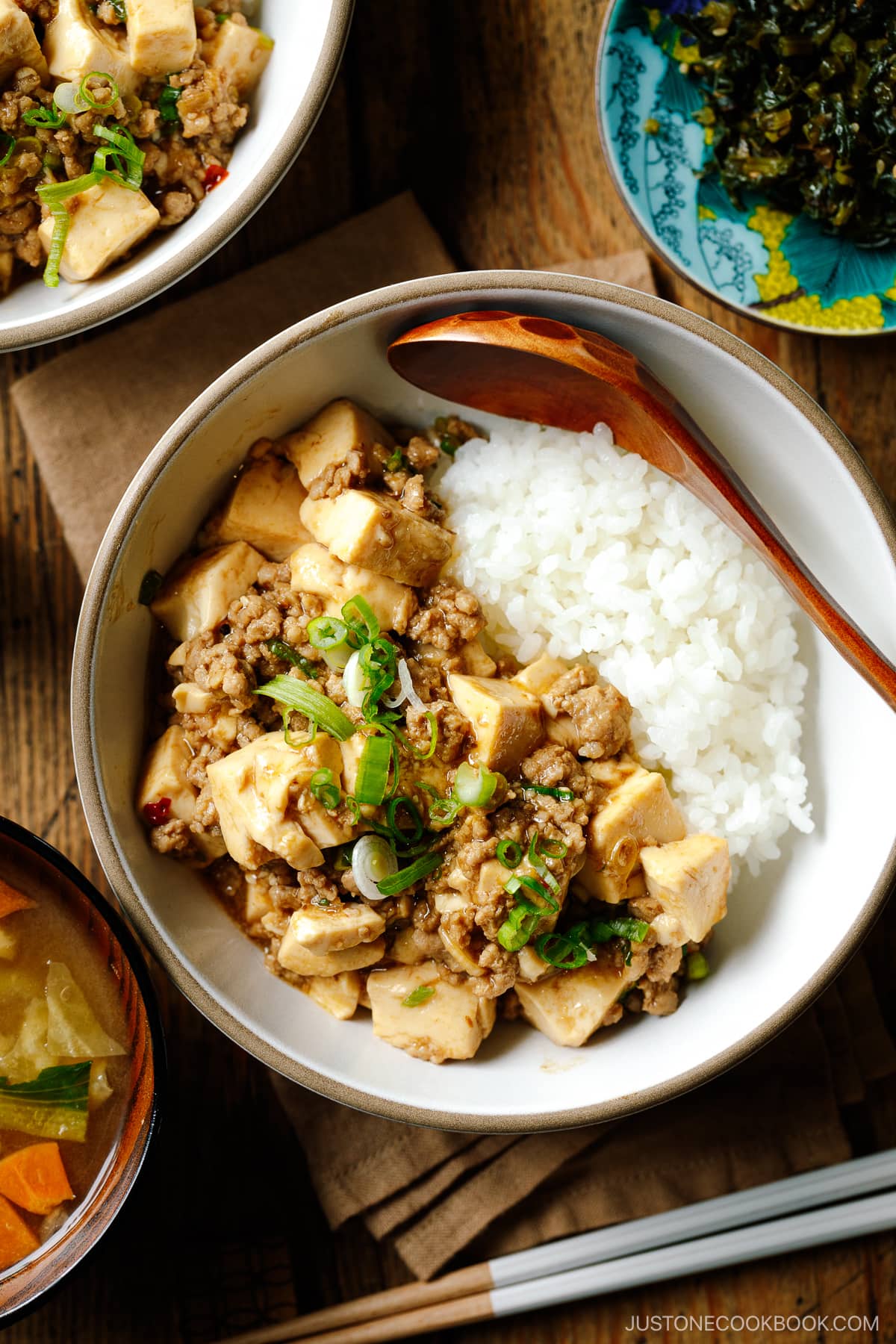
Mapo Tofu (麻婆豆腐) is easily one of our family’s favorite meals! It is so simple to make yet soul-satisfying. I love preparing this dish on a hectic weeknight when I only have 30 minutes to spare for cooking dinner for the family.
We often eat mapo tofu donburi-style, with the tofu-and-sauce mixture over fluffy steamed rice. Yes, who doesn’t like a one-bowl meal for easy cleanup? I think you and your family are going to enjoy it.
Table of Contents
What is Mapo Tofu?
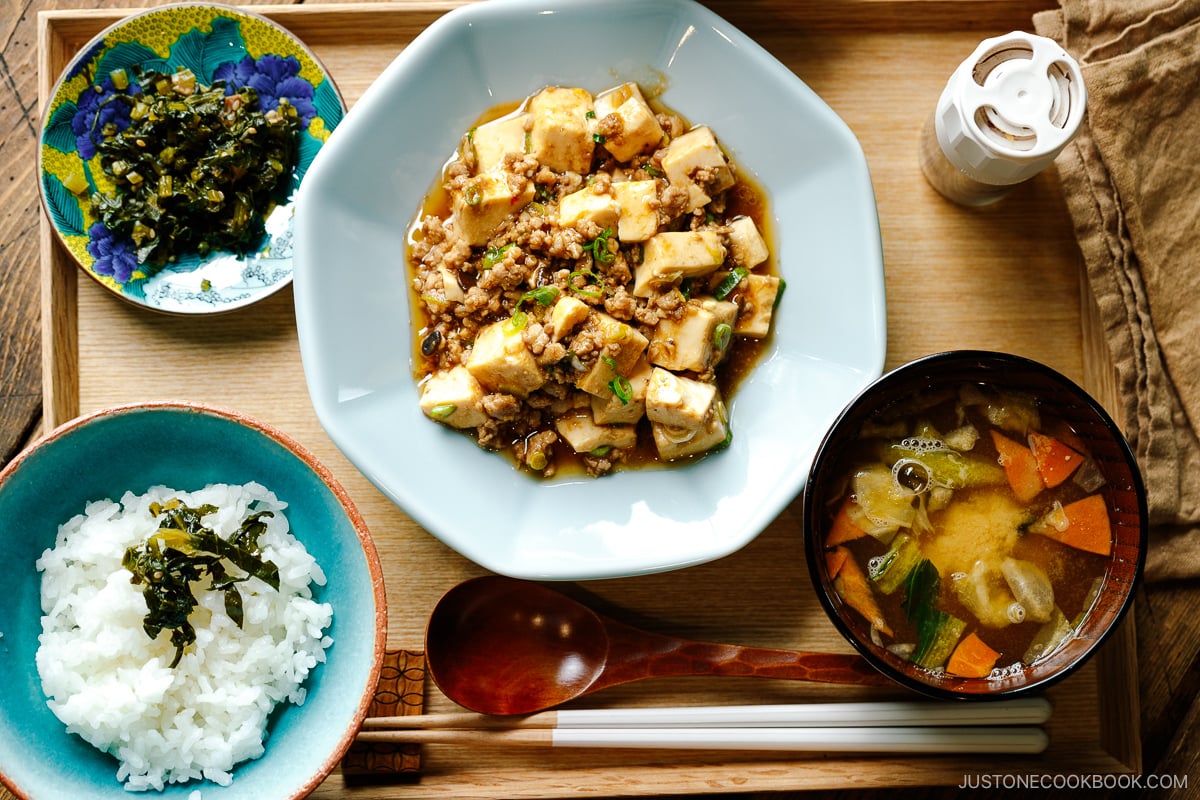
Mapo tofu is a popular Chinese dish from Sichuan province known for its fiery bright red sauce. The classic recipe is made with simmered silken tofu flavored with ground pork or beef, fermented bean paste (douban and douchi), chili oil, and Sichuan peppercorns. The dish is spicy, aromatic, deeply flavorful, and has a unique numbing character imparted from the Sichuan peppercorns.
While the Sichuan-style mapo tofu is known for its boldness and intensity, the Japanese version has a milder character as it has been adapted to the Japanese palate. Nevertheless, Japanese mapo tofu is still packed with lots of umami— thanks to the layering of flavors. Also, the spice level is tamed. If you’re looking for a not-spicy mapo tofu, this recipe is for you!
I’d say Japanese mapo tofu is ideal for anyone who is spice adverse, and even your kids will devour it.
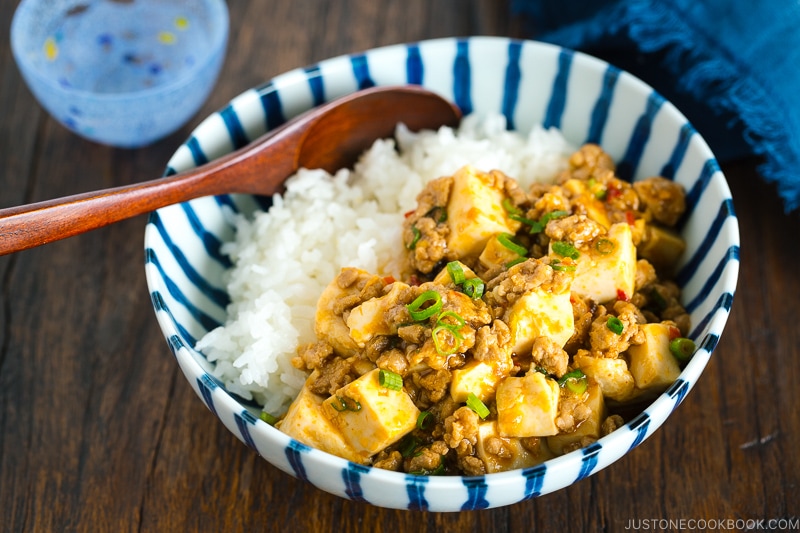
Introduction of Mapo Tofu to Japan
In Japan, mapo tofu is called mabo dofu, and it’s written either as 麻婆豆腐 or マーボー豆腐 in Japanese.
How did the dish arrive in Japan, you might wonder? It was introduced to the country in the 1970s by Chen Kenmin, a famous Chinese chef in Japan. I mentioned Chef Chen in my previous post here. He was the culinary hero that brought many popular Chinese dishes to the Chinese restaurants in Japan.
Thanks to Chef Chen, you’ll find a number of famous Chinese dishes such as mapo tofu, ebi chili (chili prawns エビチリ), and beef and bell pepper stir-fry (chin-jao ro-su 青椒肉絲) that are now part of our repertoire.
These dishes have been enjoyed in Japanese households for almost half a century! In grocery stores, you can find a whole array of convenient ready-to-eat sauces for these popular dishes. I remember seeing these packages in my mom’s kitchen pantry too.
Difference between Chinese and Japanese Mapo Tofu
There are many versions of mabo dofu within Japan, and each household cooks it differently.
So, what ingredients do the Japanese use in the dish that are not included in the original Chinese mapo tofu? Typically, we would include miso, mirin or sugar, sesame oil, oyster sauce, and occasionally sake.
Most distinctly, Japanese mabo dofu doesn’t include any chili or Sichuan peppercorn.
Most distinctly, Japanese mabo dofu doesn’t include any chili or Sichuan peppercorn. The only “spicy” element comes from doubanjiang, spicy bean paste. However, if you can find a Taiwanese brand of doubanjiang, you can buy a non-spicy doubanjiang (豆瓣酱) or spicy doubanjiang (辣豆瓣酱) with red chili in it. More about it in the next section.
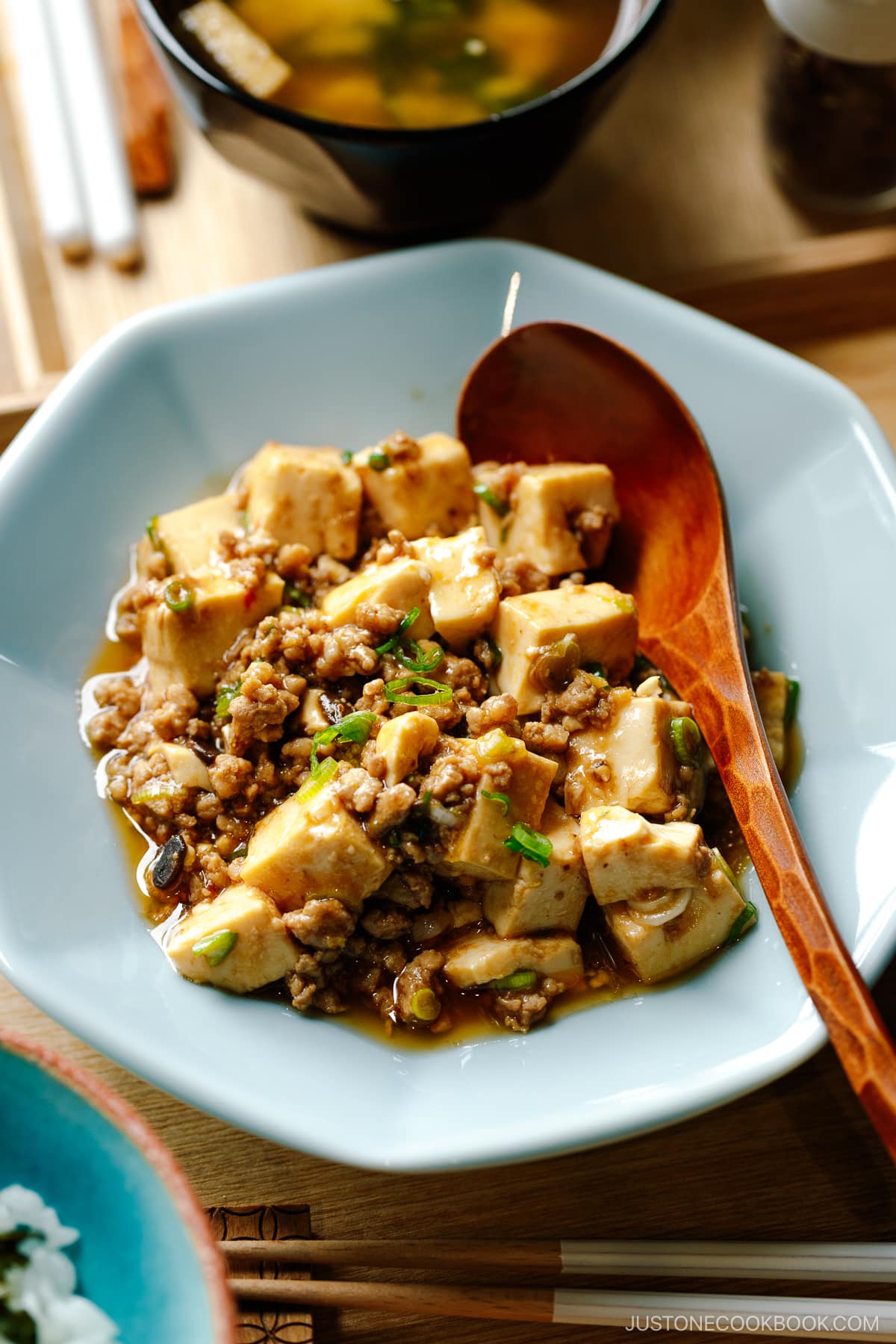
The Ingredients You’ll Need
Here’s what you’ll need for this recipe:
- Ground pork – In Japan, we always use ground pork. However, you can use ground turkey, chicken, or beef.
- Soft/silken tofu
- Aromatics: Green onions, ginger, and garlic
- Condiments: Doubanjiang (spicy/non-spicy broad bean), miso, mirin, oyster sauce, soy sauce, sesame oil, and potato starch (cornstarch)
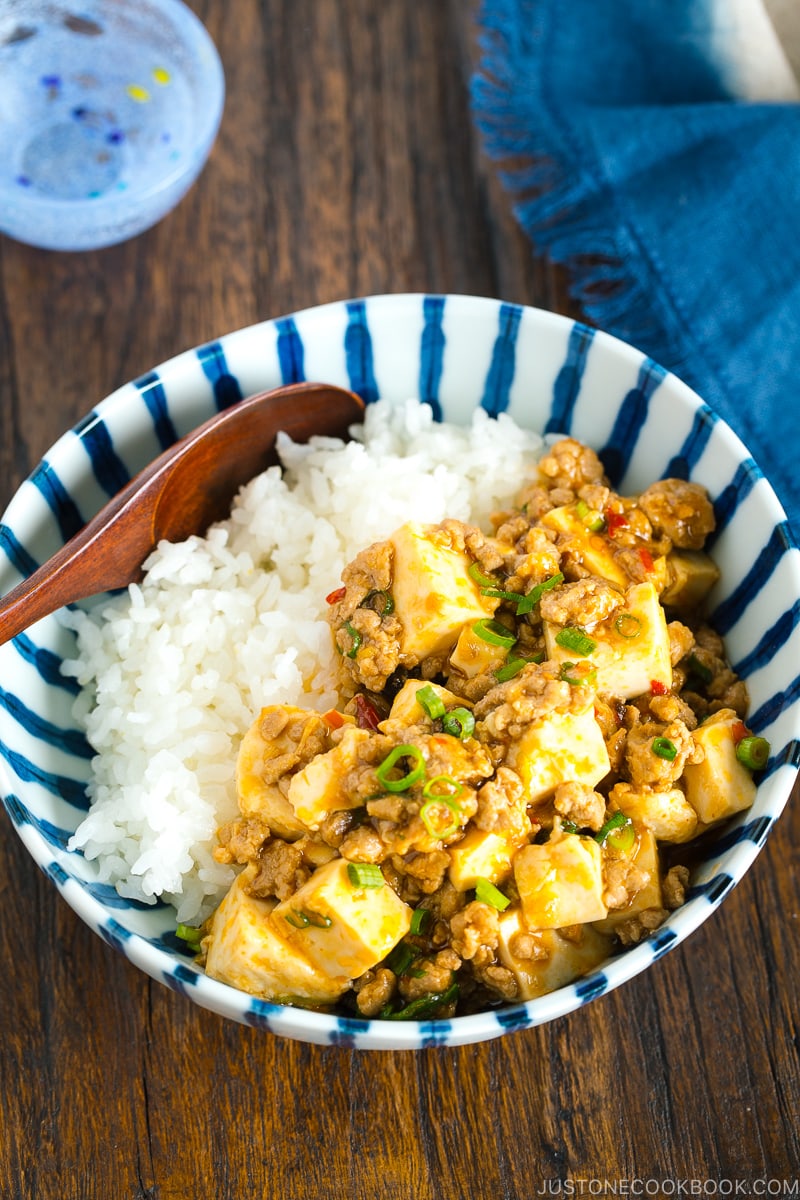
The Key Ingredient is Doubanjiang
This is truly a simple dish to make. The only caveat is you do need to have chili bean paste called doubanjiang (豆瓣酱).
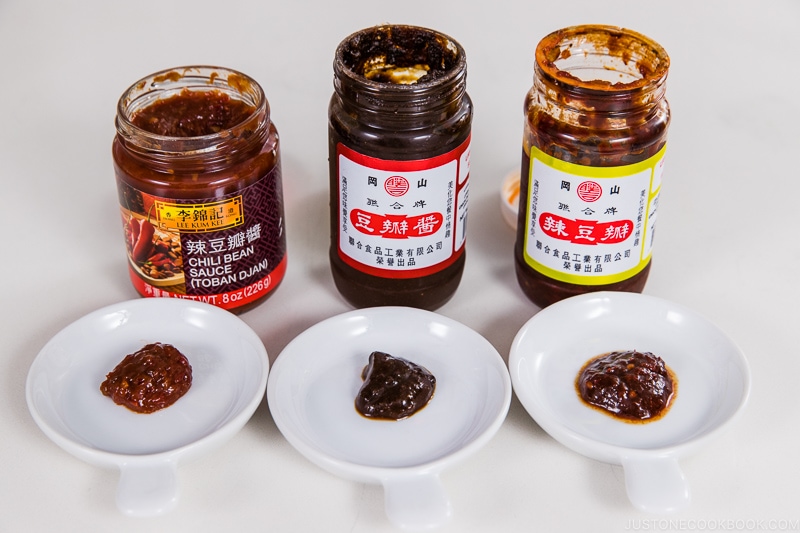
Doubanjiang is a combination of fermented broad beans as the main ingredient, soybeans, and often hot chilies. The salty, savory, umami-rich paste adds an incredible depth and character to mapo tofu that you should not substitute.
Non-Spicy Doubanjiang: Did you know that there is NON-SPICY doubanjiang? Taiwan, Hong Kong, and Guandong in China have non-spicy doubanjiang. It has the same savory depth in the paste but without the heat. To distinguish the two versions, the Sichuan doubanjiang is called la-doubanjiang (辣豆瓣醬, “la” (辣) meaning ‘hot’ or ‘spicy’).
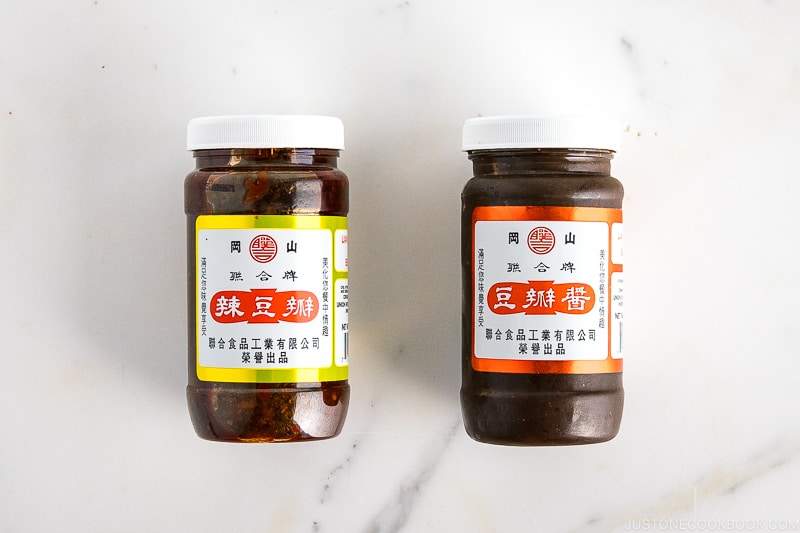
When the kids were small, I used only non-spicy doubanjiang to make my mapo tofu. Taiwanese brands like Kangshan (岡山) (above) and Ming Teh (明德) offer the doubanjiang made from fermented broad beans and soybeans, as well as the spicy version with chili.
You can get these Taiwanese brands at a local Asian grocery store (I get mine at Marina Market in San Mateo). Amazon does not sell the non-spicy doubanjiang at this time (please let me know if you find one).
- Ming Teh Doubanjiang (non-spicy) – Yummy Bazaar
- Kangshan Doubanjiang (non-spicy) – Walmart
- Kangshan Doubanjiang (non-spicy) – Weee!
Doubanjiang Substitute: If you really can’t find doubanjiang, you can use gochujang (Korean chili paste; spicy) or doenjang (Korean soybean paste; non-spicy). However, the ingredients are slightly different and have different flavor profiles.
The Best Tofu for Mapo Tofu Recipe
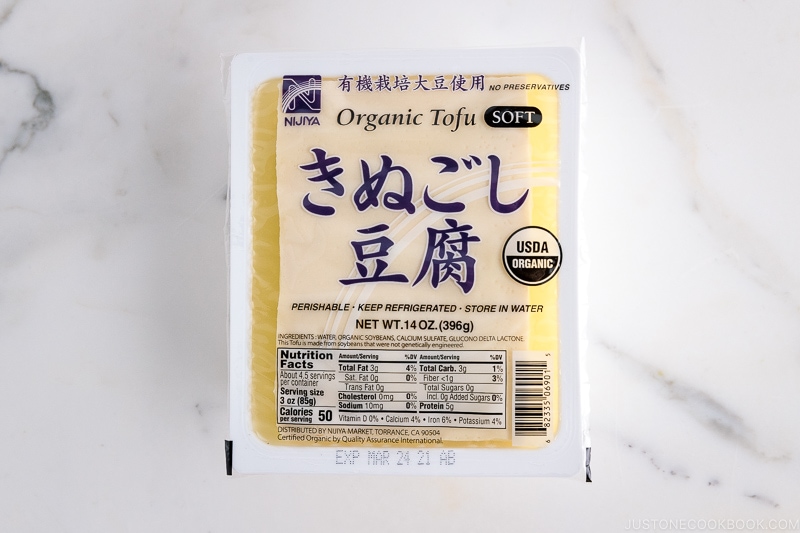
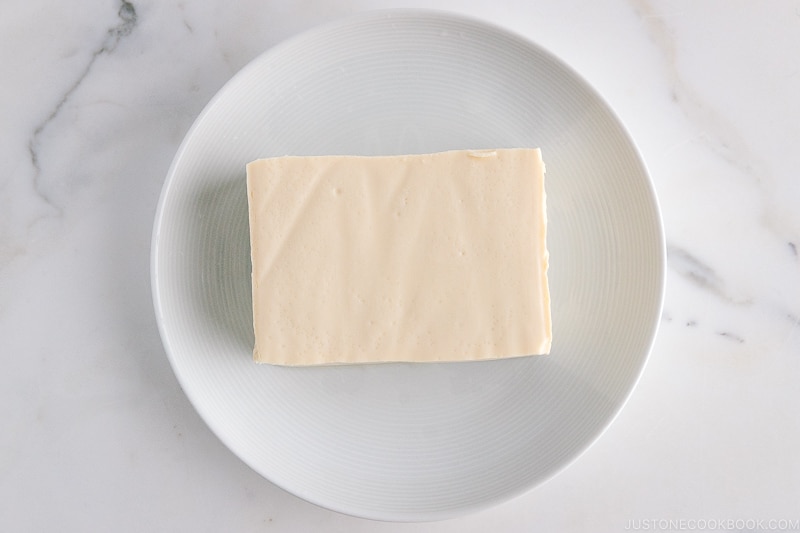
There are many different types of tofu available, but I recommend using soft tofu for the best texture. Soft tofu is smooth, soft, and creamy, which pairs beautifully with the savory sauce and ground meat. It works best for both Japanese-style mabo dofu and authentic Sichuan mapo tofu.
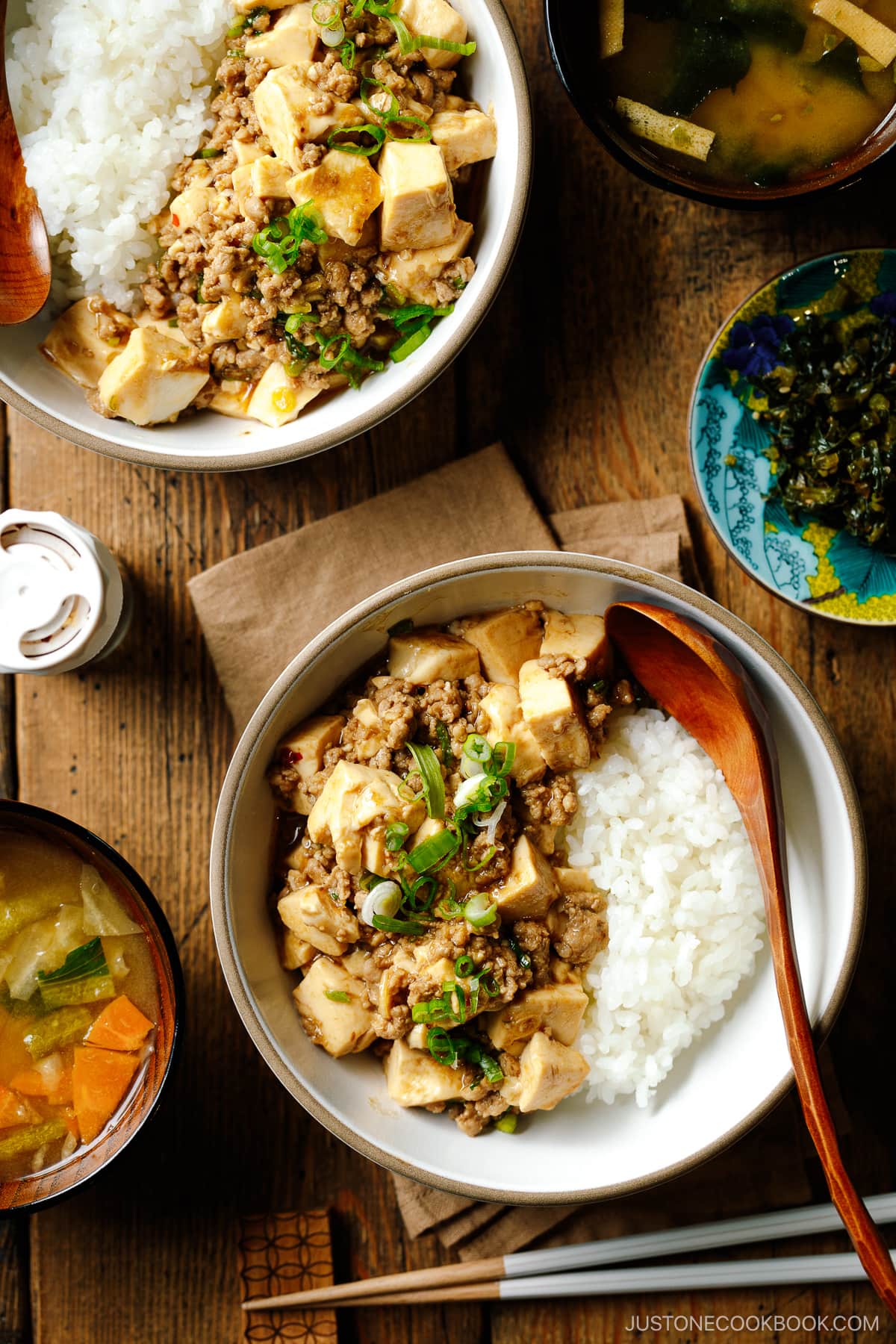
How to Make Mapo Tofu
Mapo tofu is a very easy dish, and my son can make it by himself. This was one of the first few recipes he learned to cook over the summer break one year. He loved this dish so much and wanted to be able to cook it on his own.
Here’s the overview.
- Prepare all the ingredients. Measure and combine all the seasonings before you start cooking.
- Cook the aromatics and ground pork in a frying pan or wok.
- Add the sauce ingredients and let it simmer until the sauce starts bubbling.
- Add the tofu and coat it with the sauce until the flavors infuse.
- Serve on its own or with steamed rice!
Now you have one reliably satisfying dish for the family. I hope you enjoy my Japanese Mapo Tofu recipe!
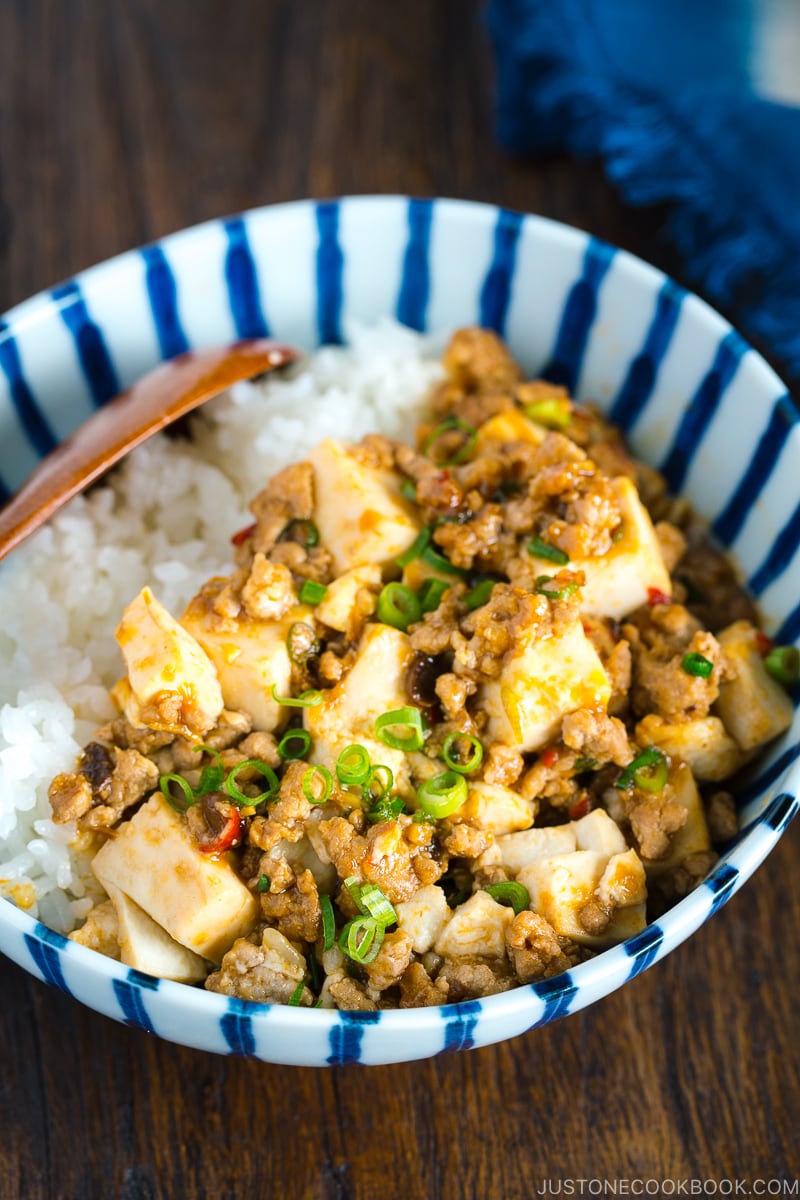
5 Cooking Tips on Making Mapo Tofu
- Measure and cut all the ingredients before cooking.
- Combine all the seasoning ingredients in a small bowl.
- Drain the tofu ahead of time for about 15 minutes. This prevents the tofu from releasing moisture into the sauce.
- Be cautious not to burn the garlic and ginger when stir-frying. You don’t want to add a burnt bitter taste to the sauce.
- Carefully stir the tofu: Tofu can easily break and become mushy. Shake the pan to coat the tofu with the sauce, minimizing spatula action.
The Wok I’m Using in This Recipe
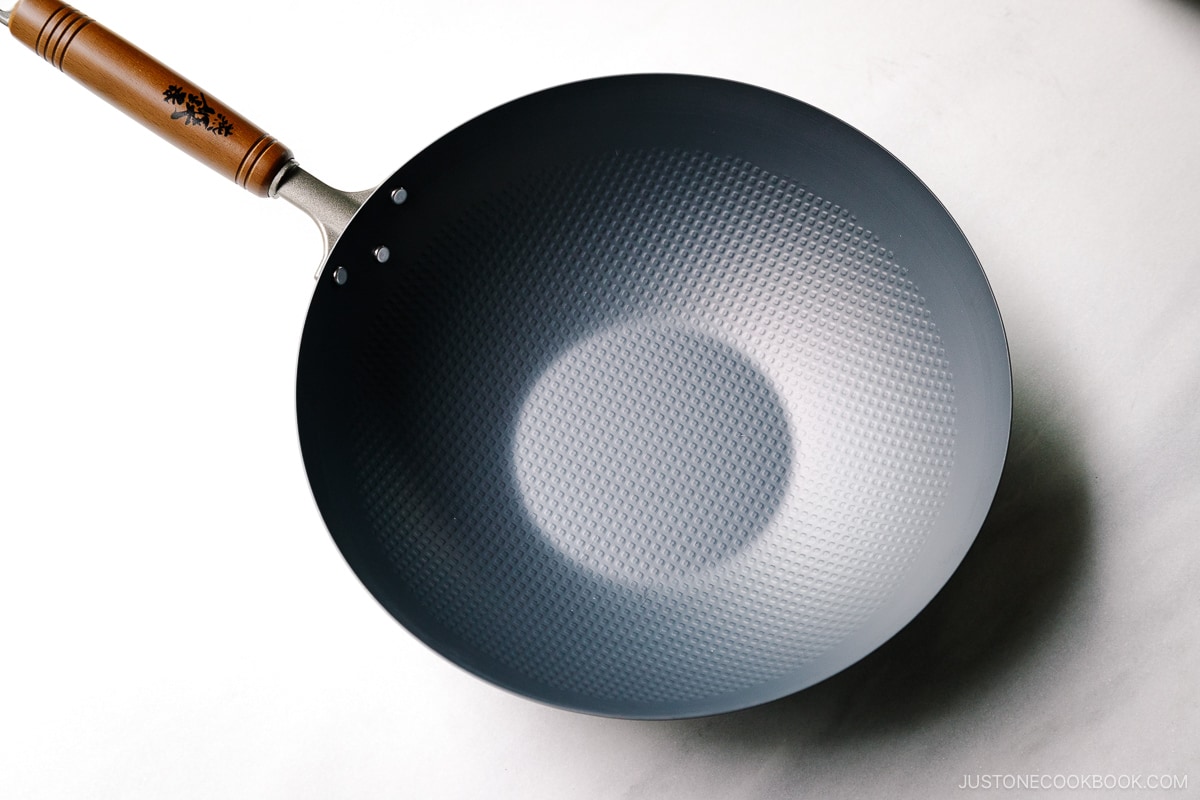
I’m partnering with MTC Kitchen, my favorite Japanese kitchen store in NYC, to try out this carbon steel wok, and I love it!
This nitrogen-hardened wok, a new series of iron cookware from Summit Japan, is infused with nitrogen, offering durability, rust resistance, and all the benefits of traditional carbon steel cookware. They are compatible with induction, gas, or electric stoves. Compared to standard carbon steel cookware, these are extremely durable and rust-proof due to the nitrogen treatment.
I really like Summit’s carbon steel series because they’re much lighter than French carbon steel pans. Their excellent heat conductivity makes them perfect for frying, stir-frying, and grilling—essential for Asian cooking! If you’re looking to invest in a carbon steel wok, I highly recommend them as they will last for years with proper care.
- Summit Nitrogen Hardened Iron Beijing Wok Pan (Embossed) 11.8″ Diameter (use JOC10 for 10% off!)
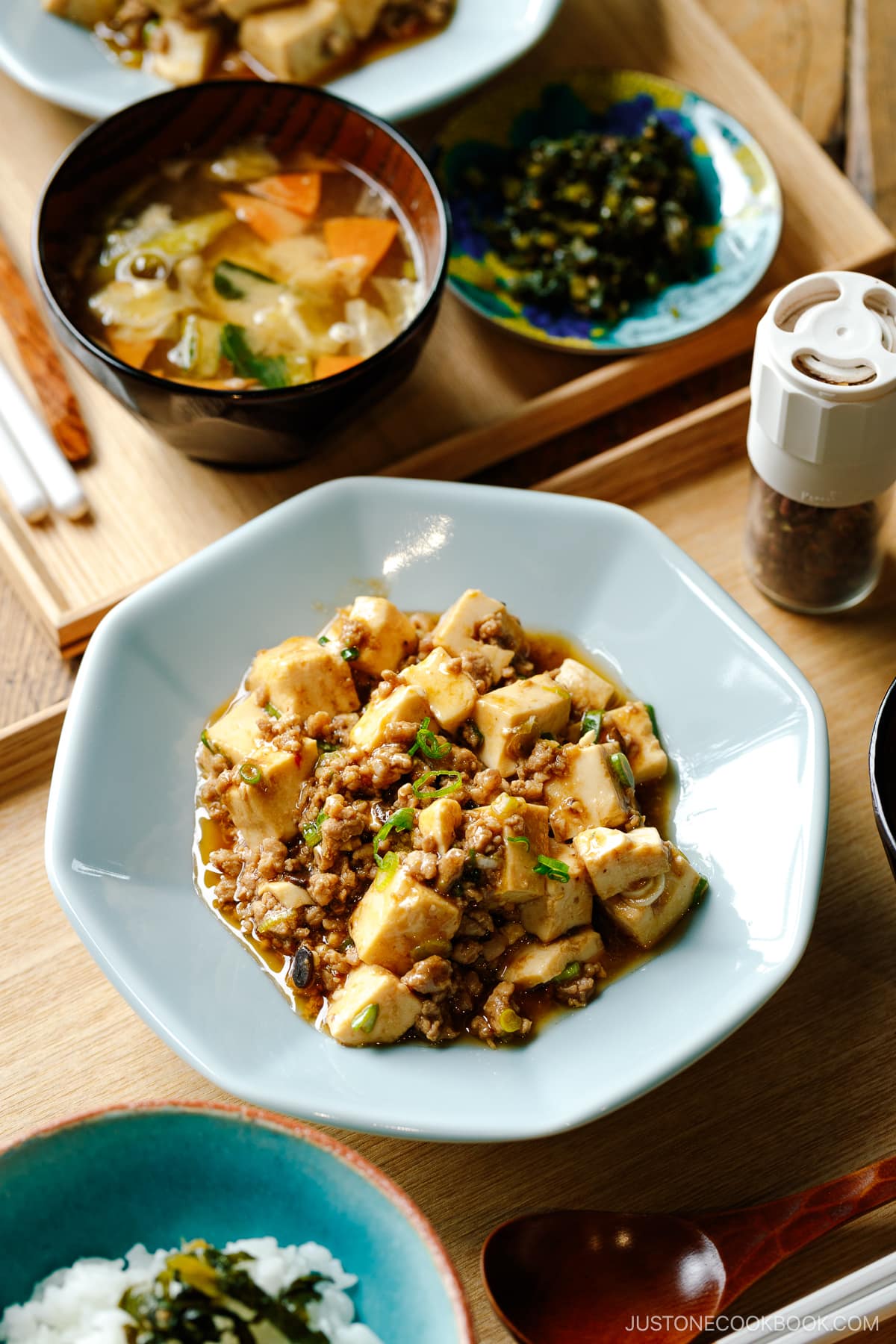
FAQs
Q: Can I use this recipe to make vegan or vegetarian mapo tofu?
Yes! Use finely diced shiitake mushrooms in place of the ground pork. Both fresh and dried mushrooms would work. Aldo, use vegetarian stir-fry sauce.
Q: Can I use another kind of ground meat instead of pork?
Sure, you can use ground chicken or turkey. Ground beef will have a stronger flavor, but it should be fine.
Q: Can I adjust the spice level?
You can cut down on doubanjiang (spicy bean paste) or use the Taiwanese non-spicy doubanjiang I mentioned earlier. If you like it slightly spicier, sprinkle la-yu (Japanese chili oil).
More Delicious Tofu Recipes
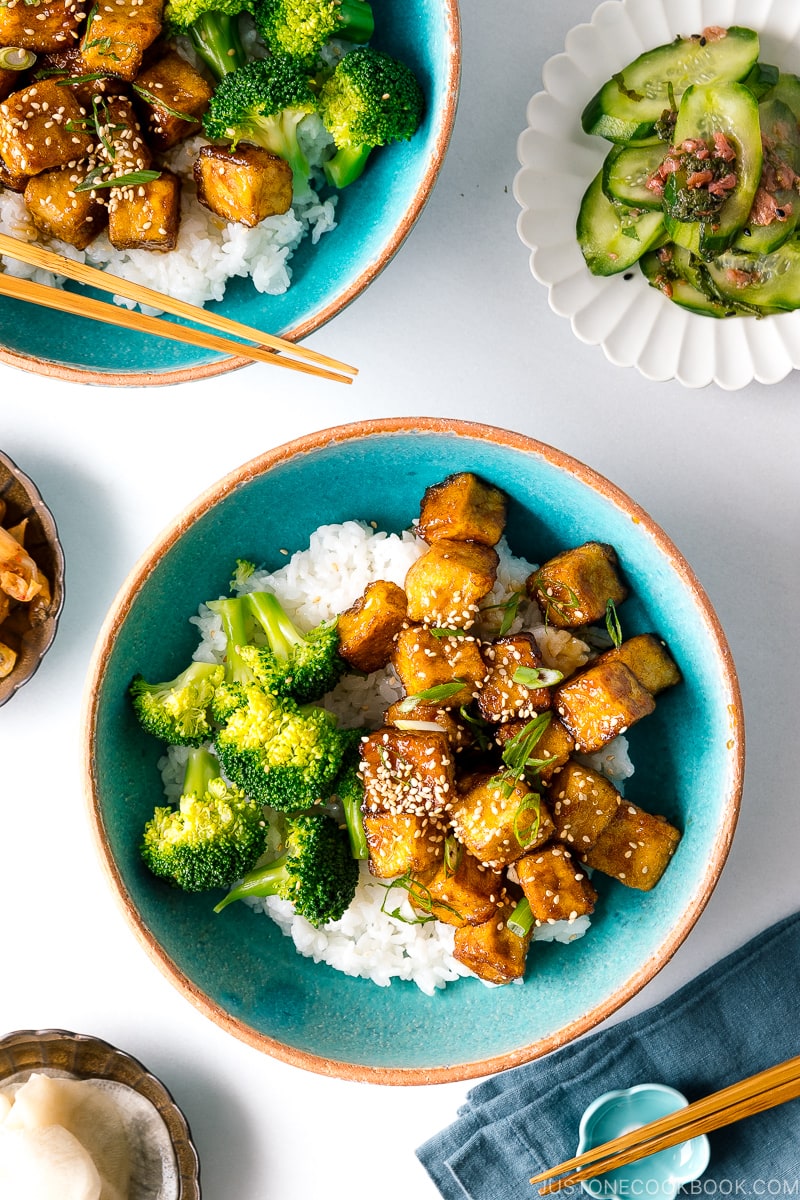
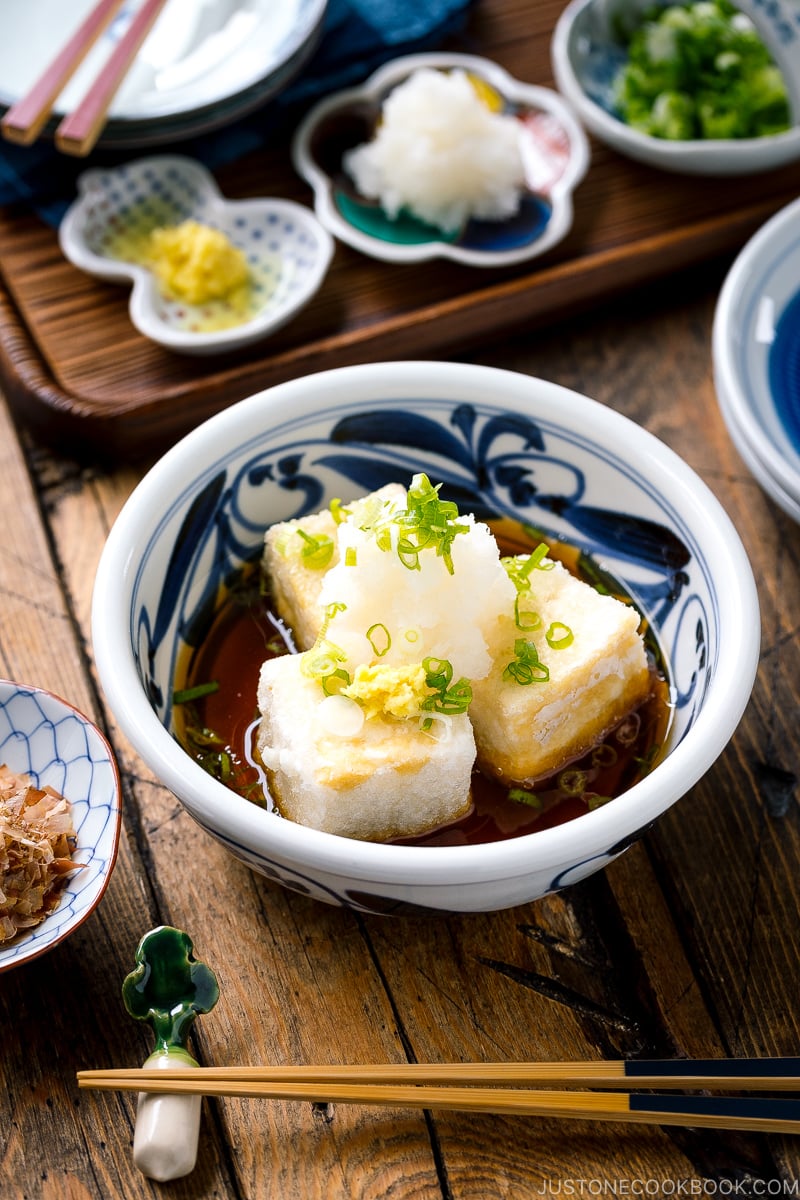
- Pan-Fried Teriyaki Tofu Bowl
- Agedashi Tofu
- Japanese-style Tofu Pizza
- Japanese Chilled Tofu
- Vegetarian Udon with Tofu
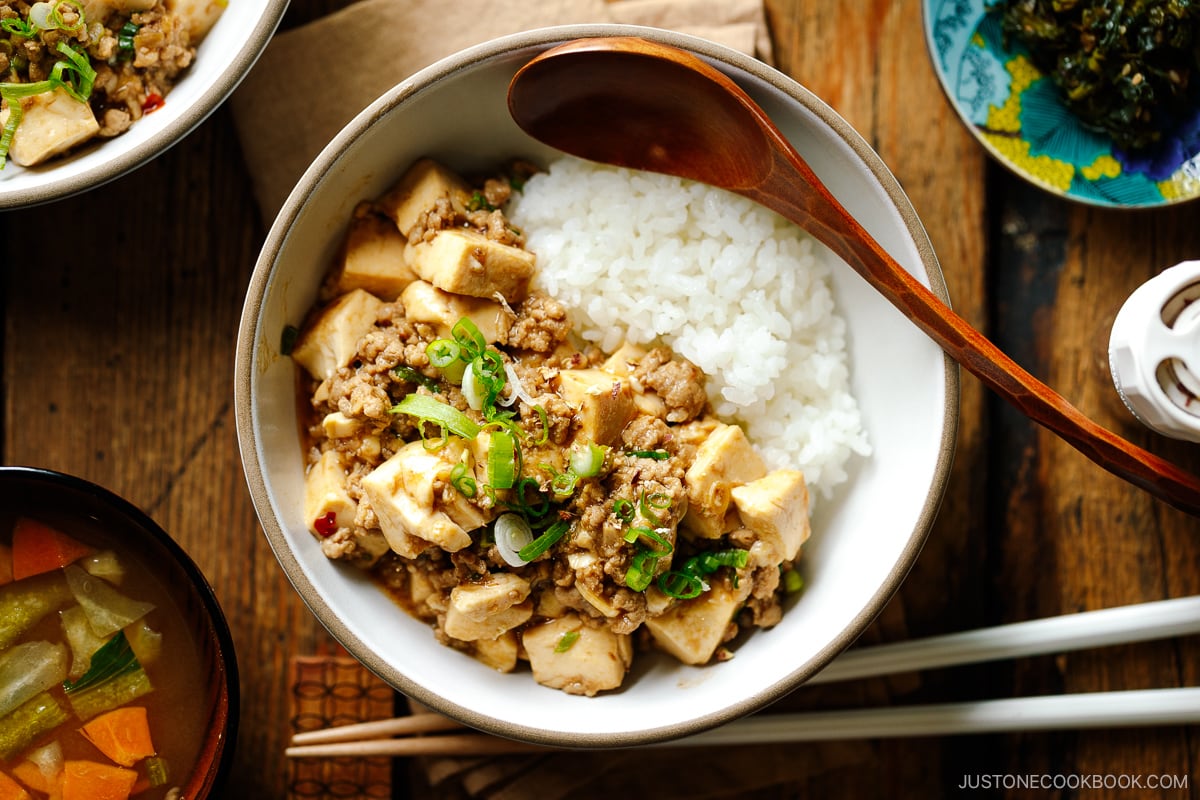
Wish to learn more about Japanese cooking? Sign up for our free newsletter to receive cooking tips & recipe updates! And stay in touch with me on Facebook, Pinterest, YouTube, and Instagram.
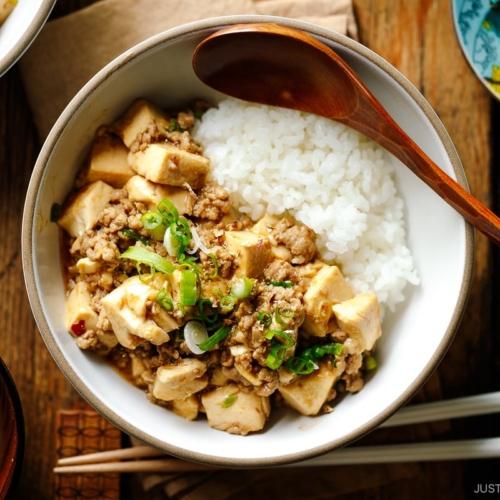
Mapo Tofu (Mabo Dofu)
Video
Ingredients
For the Seasonings
- 2½ Tbsp doubanjiang (spicy chili bean paste) (for less spicy, use 1½ Tbsp doubanjiang (non-spicy) and 1 Tbsp la doubanjiang (spicy); read more about this condiment in the blog post; use gluten-free doubanjiang for GF)
- 1 Tbsp oyster sauce
- 1 Tbsp miso
- ½ Tbsp soy sauce
- 2 Tbsp mirin
- 1 tsp toasted sesame oil
- 1 tsp potato starch or cornstarch
- 4 Tbsp water
For the Mapo Tofu
- 2 cloves garlic
- 1 Tbsp ginger (minced)
- 2 green onions/scallions
- 14 oz soft/silken tofu (kinugoshi dofu) (drain for 15–30 minutes, if you can)
- 1 Tbsp neutral oil
- ½ lb ground pork (or your choice of meat and veggies)
Instructions
- Gather all the ingredients.

- Combine all the seasonings. Add 2½ Tbsp doubanjiang (spicy chili bean paste), 1 Tbsp oyster sauce, 1 Tbsp miso, ½ Tbsp soy sauce, 2 Tbsp mirin, 1 tsp toasted sesame oil, 1 tsp potato starch or cornstarch, and 4 Tbsp water in a bowl. Mix well together with a whisk.

- Finely mince 2 cloves garlic (I use a garlic press). Peel the ginger skin thinly with a sharp knife. If you can't peel it thinly, you can scrape it off with a spoon.

- Cut the ginger into thin slices, julienne into thin strips, and then mince them. Measure 1 Tbsp ginger.

- Cut 2 green onions/scallions into small pieces.

- Drain 14 oz soft/silken tofu (kinugoshi dofu) and cut into ¾-inch (2-cm) cubes.

To Cook the Mapo Tofu
- Heat a wok or large frying pan on medium heat. When it‘s hot, add 1 Tbsp neutral oil. When the oil is hot, add the garlic and ginger to the wok.

- Sauté in the oil (make sure they don‘t burn). Once they are fragrant, add ½ lb ground pork.

- Cook the pork, breaking up big chunks with a spatula or wooden spoon, until no longer pink.

- Add the seasoning mixture and stir thoroughly. Bring the sauce to a simmer.

- Once the sauce is simmering, add the tofu and gently coat it with the sauce. Stir frequently, without mashing the tofu, until it is heated through.

- Add the green onions and stir to incorporate just before taking the pan off the heat.

To Serve
- Sprinkle sansho pepper and serve immediately.

- You can enjoy Mapo Tofu as a part of the ichiju sansai meal or over steamed rice as a one-bowl meal.

To Store
- You can keep the leftovers in an airtight container and store in the refrigerator for up to 3 days. I do not recommend freezing this dish as tofu changes its texture once frozen.
Nutrition
Editor’s Note: The post was originally published on January 29, 2011. The video was added to the post on May 6, 2016. The post has been republished with more content and new images on February 4, 2024.
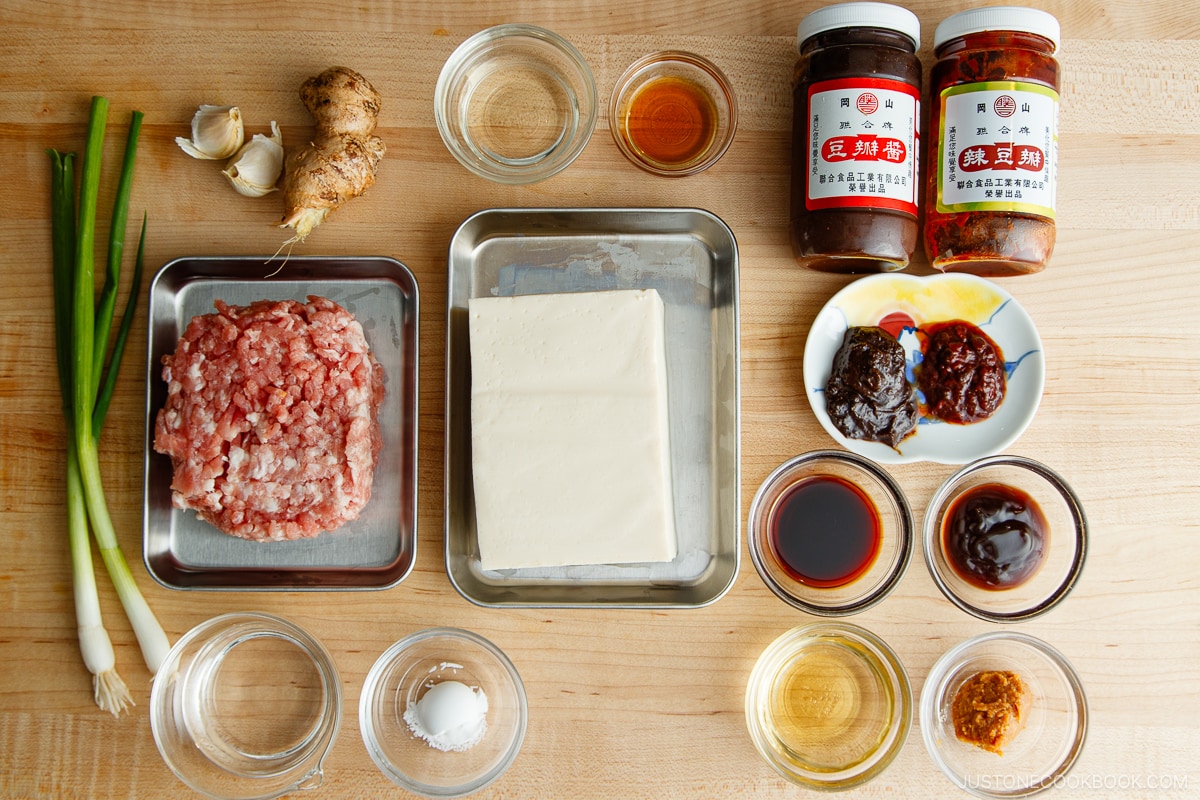
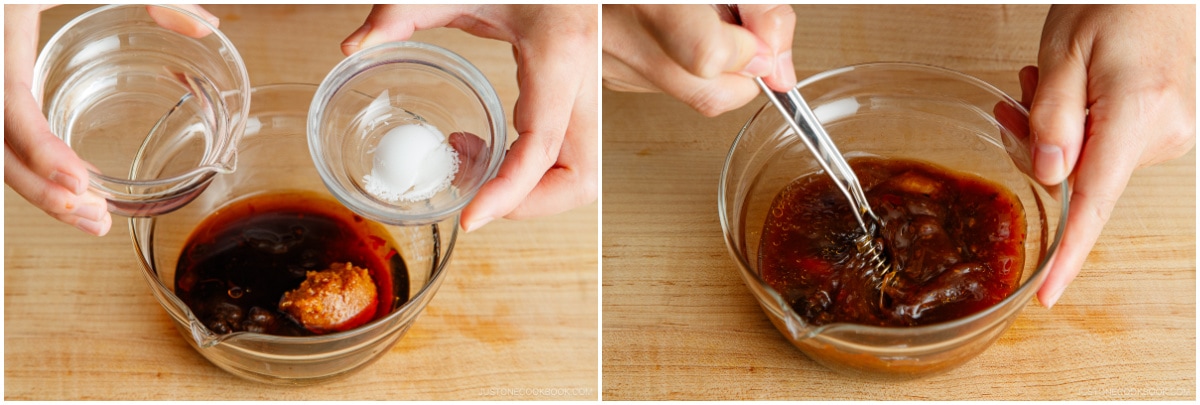


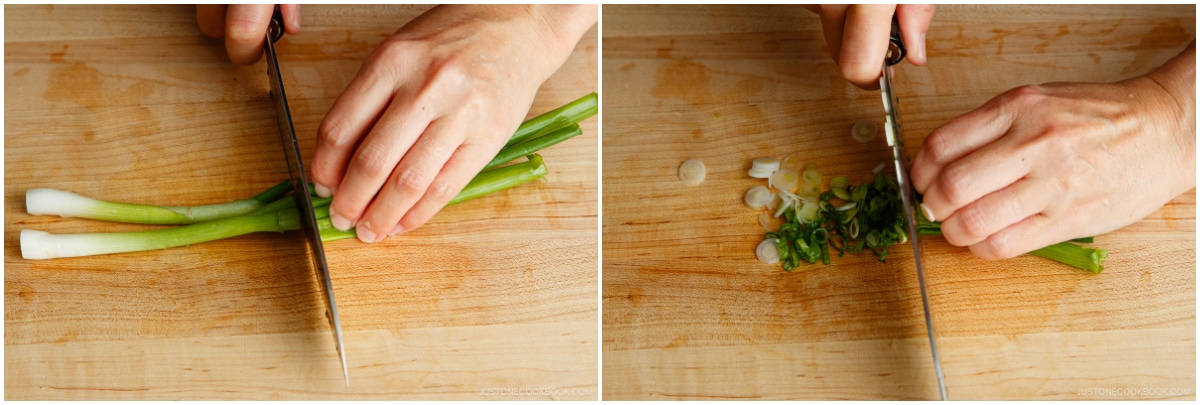
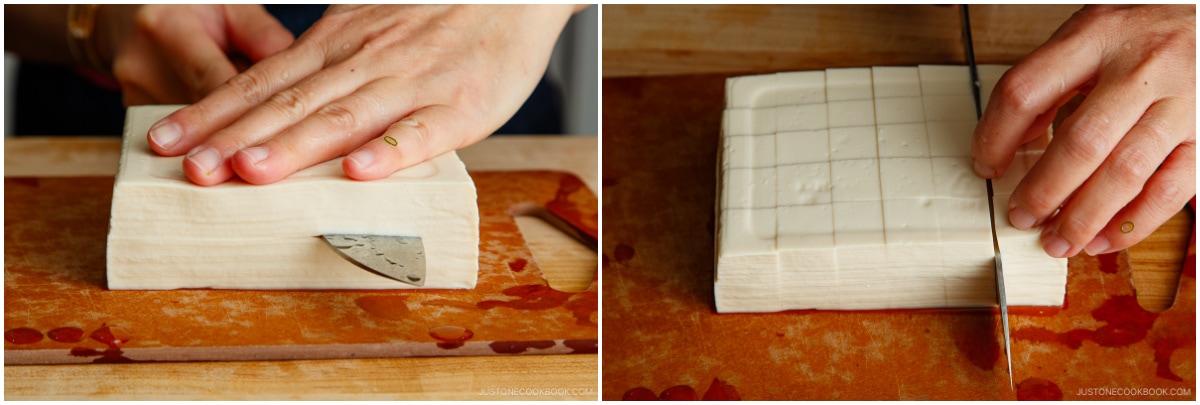
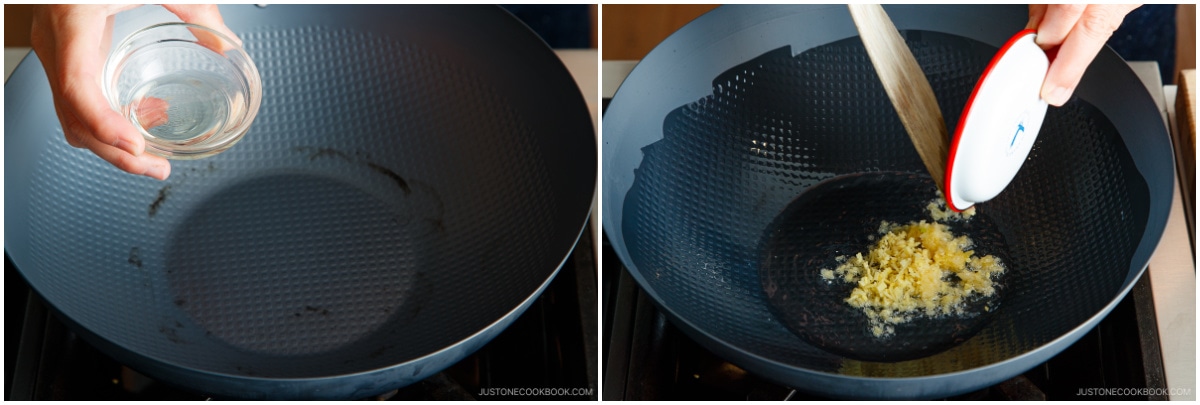
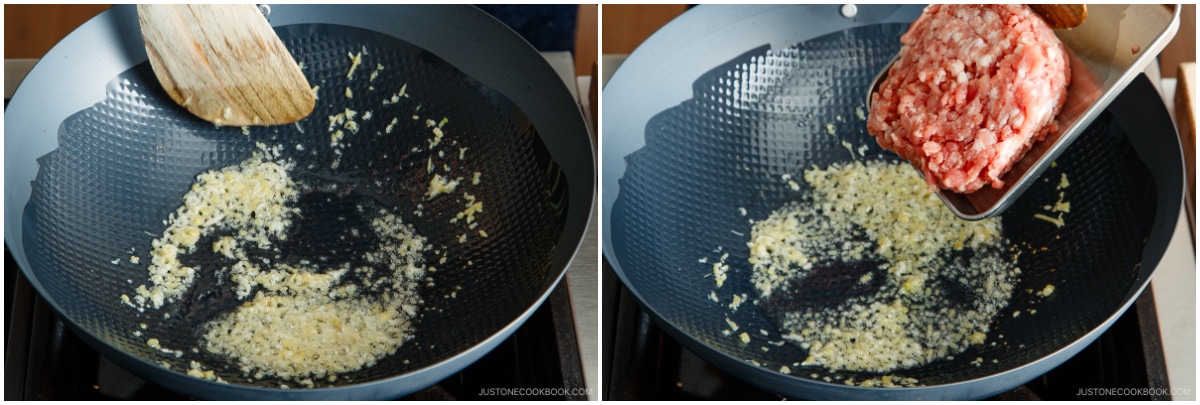
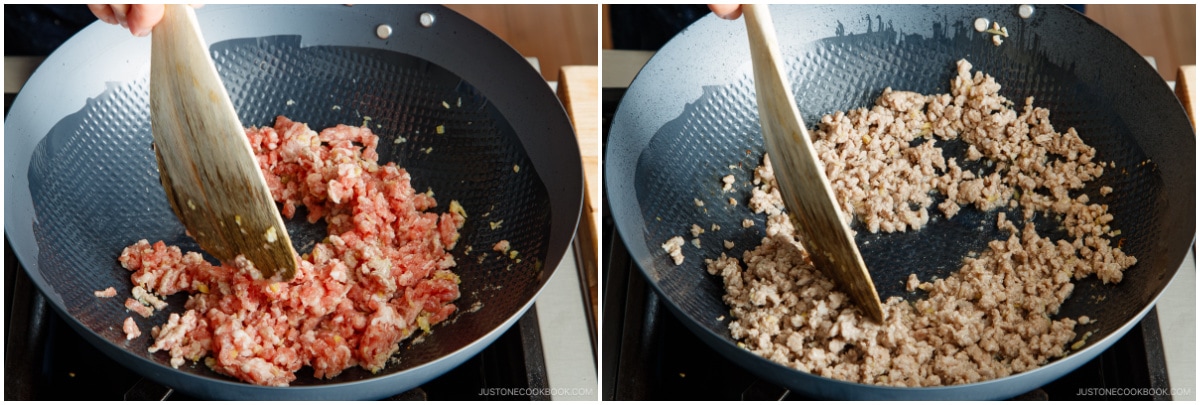

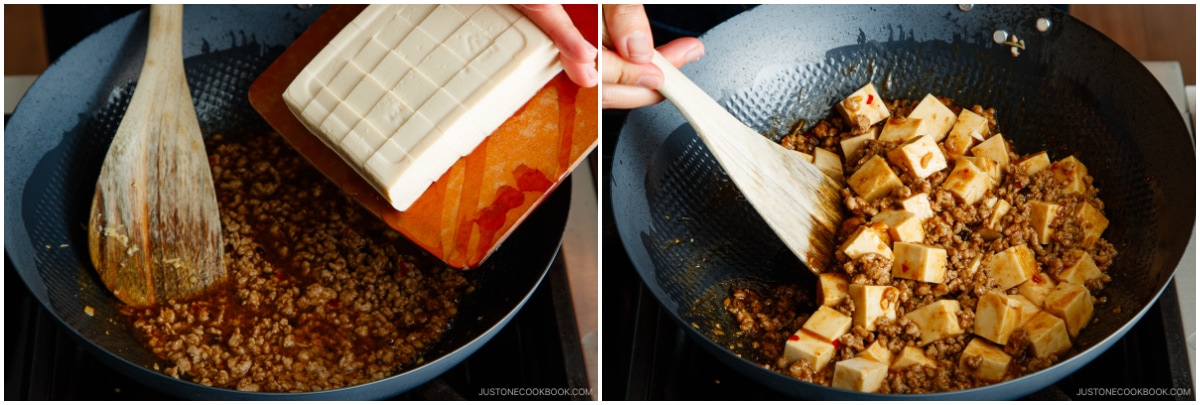
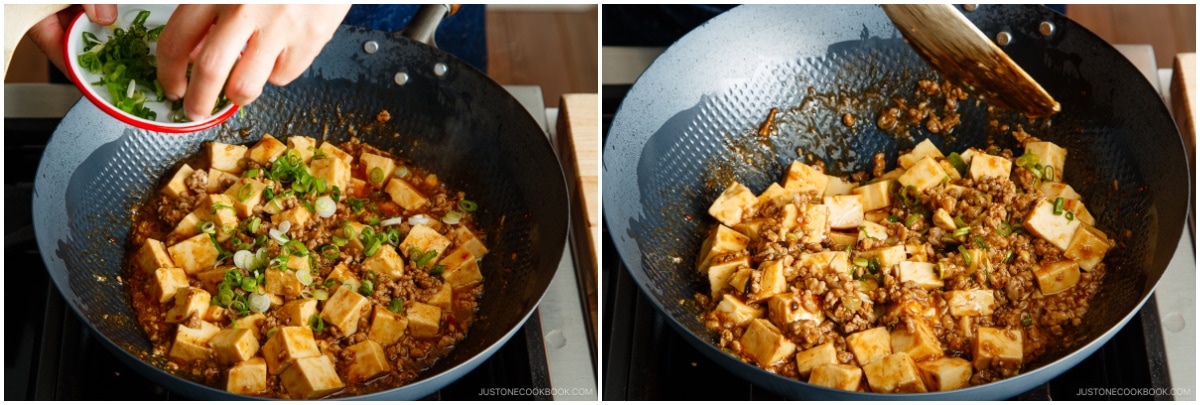
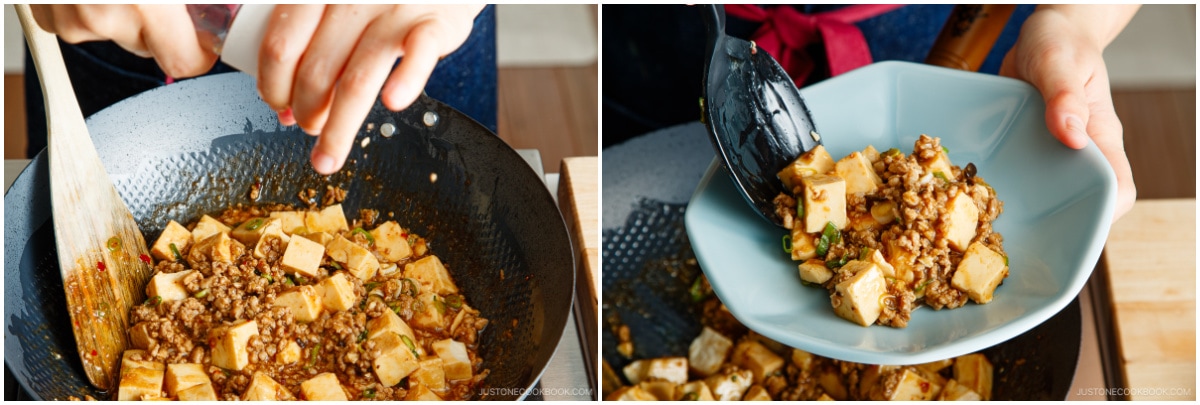
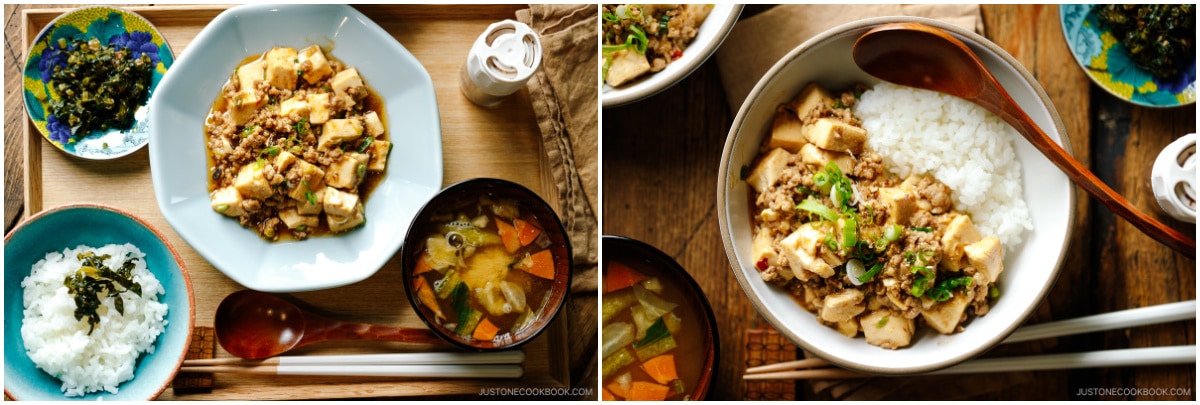


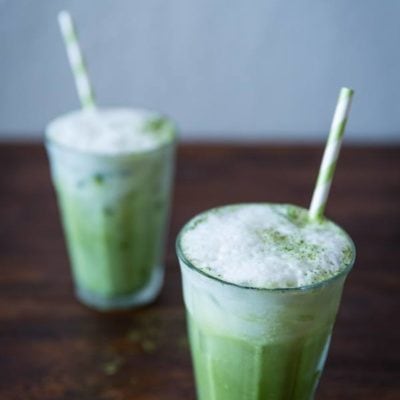




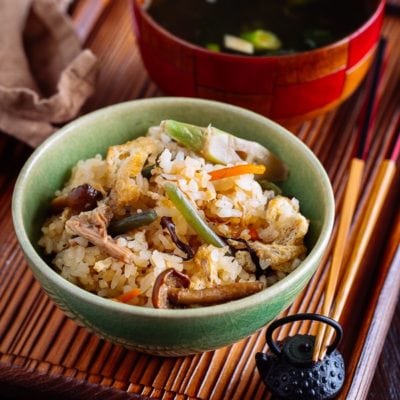
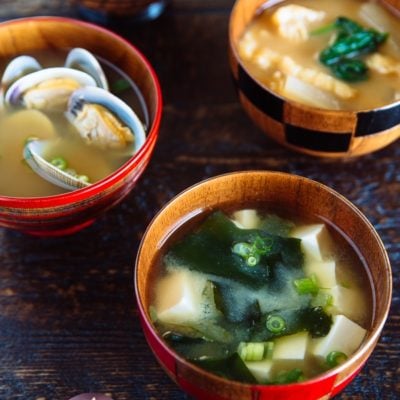


なみ-さん、こんにちは、
This is Helga from Nice,France.I am following your site for a long time now.I am very busy as a flight attendant so I did not have time yet to write to you.Now I have time,as I have to stay home for quite a time because due to a bicycle accident I broke my foot and my arm.
I am into Japanese culture since I started to fly to Japan in 1984 and my Japanese language skills are around JLPTN4 level.
Anyway,my kitchen in Nice looks like yours,maybe a little smaller,but I am like you,
Organized.As I always cook Japanese meals in my free time,I really appreciate your receipies.Most of all,when I cannot get the right ingredients,you explain so well what alternatives I can use.Thank you so much!
You are amazing!
どうもありがとうございます😊
Helga
こんにちは、ヘルガさん! Thank you so much for following me for a long time! I’m very sorry to hear about your bicycle accident. 🙁 I hope you will get better soon. I’m happy to hear you cook Japanese food in Nice! メッセージどうもありがとう。とてもうれしかったです!
Oh my gosh this dish was amazing! I made this for dinner following your recipe exactly as written and it was a huge hit in my house. I’ve recently started trying to cook Japanese cuisine and have been loving your website. Thank you for such detailed recipes and for the step by step pictures – I really appreciate that! I’m looking forward to adding this delicious recipe into my week night rotation.
Hi Kate! I’m so happy to hear you enjoy my recipes and thank you for your kind words! 🙂
I live in Honolulu, Hawaii. Where can I get the Doubanjiang ( non-spicy)??
I can’t find in Asian markets that I’ve been to.
Hi Cheryl! Non spicy ones can be found in a Chinese grocery store as I can’t find on Amazon. Check the 岡山 brand (manufacturer is in the Bay Area).
https://www.justonecookbook.com/doubanjiang-chili-bean-paste/
I don’t live in Hawaii, so I’m not familiar with the Chinese stores there.
This was so delicious and so easy to prepare! Thank you so much! No more prepackaged sauce for me!
Hi Lisa! I’m so glad you tried this recipe and enjoyed it. Thank you for your kind feedback! Yep, no more packaged sauce! 😀
Hi can I omit the doubanjiang chili bean paste? We dont eat spicy, what alternative i can use? Thank you 😊
Hi Joliza! My kids didn’t eat spicy for a long time (now they can eat more), and I always used non-spicy doubanjiang (see the picture here: https://www.justonecookbook.com/doubanjiang-chili-bean-paste/). Without doubanjiang, I feel like it’s not Mapo Tofu… to keep it authentic you must have doubanjiang taste in the sauce. 🙂
Your recipe is quick, easy and delicious. So much healthier and better tasting than the store packaged version. I make this often. Thank you.
Hi Miko! I’m glad to hear you enjoyed this recipe! My family loves this dish. Thank you for your kind feedback. xo
[…] Use them as a substitute for meat to make vegetarian mapo tofu […]
I only really got into cooking (real cooking, not just salads!!) a few months ago. Mapo tofu has always been my favourite Chinese dish. I currently live in a small town in Hokkaido, Japan, where I don’t have access to all the variety of ingredients I could buy in Canada. But luckily there’s a small section of an aisle dedicate to Chinese cuisine in the local supermarket. Today, a dream came true! I made mapo tofu for the first time, following this recipe to a T, and it turned out beyond amazing!! I wouldn’t change a thing about it. 🙂 Actually, I did change two minor things: 1. I only used ladoubanjan, which was perfect because I like it spicy. (The bottle’s labeled toubanjan, but I can tell it’s ladoubanjan, coz it’s much redder than the regular toubanjan). 2. I used ‘momen’ tofu, while in the video it looks like ‘kinugoshi’ tofu was used. I don’t think it makes much of a difference at all. It was the perfect, silky, soft texture that I wanted.
Oh, and the miso I used had dashi in it. Nooo problem 🙂
Ah, dang it, I forgot one more thing: I used ‘katakuriko’ (potato starch) instead of corn starch!
Yeah all your variation of ingredients doesn’t make a huge difference. 🙂
Hi Farid! Thank you for trying this recipe and I’m so happy to hear you enjoyed my mapo tofu recipe! It’s easy dish to make, so you will enjoy your favorite dish more frequently at home! Thank you for your kind and detailed feedback. xo
Too many advertisements. It makes it hard to read and pictures take a longer time to load due to the advertisements.
Hi Yininn! I’m sorry for your bad experience on our site and thank you for your feedback. We’ll include your feedback and will consider how we run our ads.
[…] 12. Mapo Tofu 麻婆豆腐 […]
Hey!
Thanks for this recipe! Ihave been doing Mabo Nasu with ground beef for a year now (Tried it with beef, and in France I have never seen ground pork, so this is easier :)). I have a vegetarian friend and was wondering if I could just use tofu instead of the meat? If yes, what kind of tofu? Thanks a lot 🙂
Hello Emmanuelle! How interesting that there is no ground pork sold in France! Yes, you can use tofu – I recommend using firm tofu (but drain well too) or deep-fried tofu (if you can find in an Asian grocery store). You can basically add at the end just to warm up (otherwise tofu can become crumble while stirring). Deep-fried tofu on the other hand won’t break into pieces so you can stir fry. If you can’t find deep-fried tofu, you can oven bake firm tofu first too. 🙂
[…] tofu är en kinesisk rätt som japanifierats och gillas av många. Min variant är baserad på detta recept, med ett par små modifikationer. Just denna gången hade vi doubanjiang från ett nytt […]
[…] Coconut Risotto with Shrimp Cheddar and Spinach Piroshiki Whole Roasted Chicken Mapo Tofu […]
Hello! I am really looking forward to trying this meal, and have all the listed ingredients for this recipe, but cannot find Doubanjiang (on Amazon it is $31!). Is there a website you recommend that I can purchase? Or an alternative?
Hi Rachel! I am so sorry for my late response. Assuming that you’re in the US, I found the sauce on Amazon here:
https://amzn.to/2MAjDv3
And much cheaper at Asian Food Grocers:
https://www.asianfoodgrocer.com/asian-food/sauces-seasoning/chinese-sauces/uc-hot-bean-sauce
Let me know if you need help! I’ll be happy to help out!
Thanks Nami! I was hoping to find the non-spicy version, but will try this.
Hello Nami!
I was wondering if you knew how to make Mabo Nasu… I loved this recipe and was happy that my little one loved it. I’m just not sure how to make this recipe with Japanese eggplant. Please let me know! 🙂
Kristin
Hi Kristin! Mabo Nasu in Japan is actually Japanese style, and it’s same sauce as Mabo Tofu. However, this dish in Chinese cuisine is:
https://www.chinasichuanfood.com/yu-xiang-qie-zi-sichuan-eggplant/
And there is no Doubanjiang or pepper involved in Chinese version. Sometimes vinegar or sugar is added.
I’m not sure which version you’re interested… but Japanese version is basically same as Mabo Tofu.
Now, if you want to use my recipe, you can deep fry the eggplants with oil (Suage – no coating, just deep fry) before mixing with the sauce. 🙂
Hope that helps!